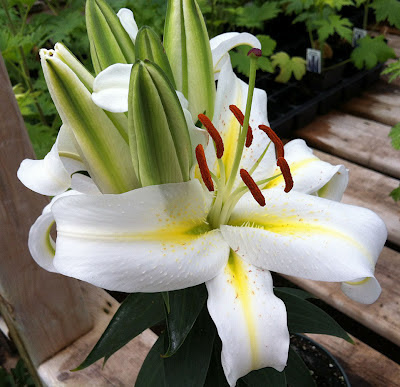It's that time of year when daylilies are popping out everywhere, and sure as eggs are eggs, someone will innocently refer to them as 'lilies'. So I thought that it was time to have a quiet chat about some of the differences between the two families of flowering plants.
Daylilies: Botanical name is Hemerocallis, which translates from the Greek to "beauty for a day". Which, coincidentally, is the length of time each individual flower on a plant lasts. There are a few different species of Hemerocallis, but thousands, and I do mean thousands, of named cultivars.
Lilies: Botanical name is Lilium. These are the true lilies. There are a number of different species of lilies, including Orientals, Asiatics, Martagon, and many others. But they're all true lilies.
(Golden Stargazer, an Oriental lily, highly fragrant and gorgeous.)
Daylilies grow from thick, fleshy tubers or rhizomes. Here's a photo of some daylily roots. Each one holds one crown, or "fan" of daylily leaves.
Daylilies have grassy foliage. The flowers are held on sturdy stems called scapes, which emerge from the crown (growing point) of the plant. Each scape can hold many individual flowers, and some scapes are branched and have even more flowers. The first year or so of a daylily's life it may only have one or two scapes, but as the plants multiply they produce many more scapes and many more flowers. (This is a fancy variety called Spacecoast Gone Bulldogging', at Canning Daylily Gardens here in Canning, NS.
True lilies have a central stem with leaves arranged in a whorl all around the stem. The flowers are born at or near the top of that stem. (I've had this Asiatic lily for years and have no idea what its name is. Big, vigourous and deep pink, no scent of course).
At a place like Canning Daylily Gardens, you'll see hundreds of different varieties of daylilies, in a huge array of colours. It's a great place to go to get excited about growing these wonderful plants, which are quite easy to grow.
This is 'Luzia', a white Oriental lily, showing its cluster of buds arranged at the top of the plant. Some true lilies are dwarf and suited to growing in containers, while others are best grown in a garden setting.
('Starman's Quest', one of my favourite daylilies. It is quite near another favourite, Timelord. Alas, there is no Tardis daylily, yet.)
This species of lily has been in my garden since before we bought the place, so I'm not certain of the species and don't know the variety at all. It's lovely, and a later-bloomer.)
There, hopefully this brief primer will help people to understand why daylily enthusiasts correct those who refer to their plants as 'lilies.' Both families have plenty of amazing cultivars to choose from, but neither of them have true blue flowers. So maybe that's a project we can work on!










